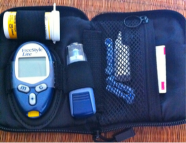Design & Thinking Movie April 30, 2012
Posted by Laura Brandner in Uncategorized.1 comment so far
Hey, don’t we know that guy at 1:21??
Wired To Care February 12, 2012
Posted by Laura Brandner in Wired to Care.12 comments
At least eight times a day, every day, for two weeks. That’s how often I tested my blood glucose as part of a clinical study at work (Abbott Diabetes Care). I had two transmitters adhered to my body, carried around two glucose meters (that couldn’t be more than 10 ft away at any time), and lugged supplies like test strips, lancets, a lancing device, and hand sanitizer with me at all times. I had volunteered for this study for the experience. I wanted to get a small glimpse into what life was like for someone with diabetes – understand their frustrations with a product, prick my fingers constantly, figure out how to test discreetly, and feel what it was like to answer the inevitable questions I would get when testing.
Around the time I started the study I also started reading Wired To Care, by Dev Patnaik. The book focuses on how empathy for customers can help companies create better products and services, and even how this empathy can create meaning around one’s job. As I turned the pages and felt the pricks in my fingers, I identified completely.
The book describes many compelling examples that show how empathy for customers has created value for companies. It shows how companies thrive by hiring the customers they are serving (Microsoft’s Xbox, Harley Davidson, Nike), how companies struggle when they lose touch with their customers (Maxwell House’s Robusta Blend, American car manufacturers’ incentive for employees to buy only the cars they make), and how companies’ close contact with customers helps them adapt over time (Zildjian cymbals, London Farmers’ Markets). All the stories demonstrate that in order for companies to succeed, they should rely on the human impulse to care. People want to do what is right; the issue may just be that the employees are so removed from the customers that the company forgets who it is serving. This connects closely with the problem reframing we are learning about in class. One needs to understand the customer’s issues and circumstances to define the true problem before creating something that works for them.
The book gives more stories and examples than actual tools to create empathy, but there are a few suggestions:
1. Make it easy
2. Make it everyday
3. Make it experiential
Some examples of these tactics include:
– Target headquarters in Minneapolis has a Target store next door so employees can easily hang out with shoppers
– Sporting goods company Spalding built basketball courts outside the main office so employees are encouraged to use their products constantly
– Nike headquarters in Beaverton, OR has miles of running trails on campus and images/memorabilia of their athletes everywhere so employees are inspired and energized
For some companies it would be more difficult for employees to walk in customers’ shoes (investment firms, pharmaceutical companies, senior citizen care), but the effort should be made to truly understand the customer and what matters to them.
At my company, we get constant reminders of the people we serve. We have letters up around the office from customers who say how much we’ve helped them manage their disease. At all-hands meetings, we see videos of families where young children are growing up with diabetes and how our products become integral parts of their lives. Once a year we have a “Connect to a Customer” event where we get the opportunity to listen to customer service calls and hear what customers are saying about our products. It is eye-opening to hear real-time examples of issues people have with things we think are so intuitive. Since we are so close to the product, it is important to step back and realize how people are using them in the real world. It is also important to step back and realize the impact we are having on peoples’ lives.
The last few chapters of the book begin to focus on how corporate empathy can actually make an organization a better place to work. When employees feel like their work is valued and that they are part of something larger, the work is more meaningful. All products and services do have the potential to make someone’s life better; it just may take some digging to figure out the right message for both the customer and the employees. A strong connection to the people with diabetes I serve makes it easier for me to go to work and know that what I do is important to someone’s well being.
Since humans truly are wired to care, we should focus on cultivating that to make our careers and companies more valuable. This book helps bring examples of empathy to life and shows how widespread empathy can make a positive change in organizations.







